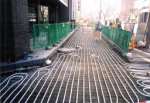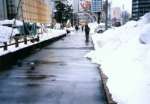
- products: brazed | double wall brazed | shell and tube | shell & coil | pool heaters | air to water
- applications: radiant floor heating | snow melting systems | district heating
 Heat
Exchangers for Snow Melting Systems
Heat
Exchangers for Snow Melting Systems
Tired of hurting your back shoveling snow off your driveway, slipping and falling on the hard ice and dragging all that salt and sand into your house? It's no secret that snow melting systems are one of the best ways to reduce the costs of a long hard winter. But these systems are even more effective when they use a brazed heat exchanger to supply the system with hot glycol. Our brazed heat exchangers allow you to lower your boiler temperature because they don't require as great a temperature differential as a shell and tube heat exchanger, saving you a considerable amount of energy and money. These heat exchangers are not only surprisingly more efficient than the shell and tube alternative, their compact size is perfect for those situations where space is restricted and hard to access.
What Are Snow Melting Systems?
 A
snow and ice melting system is a heating system that circulates hot glycol
through a network of pipes located outside under everything from driveways
and sidewalks to patios and parking lots keeping them free of snow and
ice. These heated driveways or patios consist of thermoplastic piping
embedded in concrete which carry the hot glycol supplied by a central
heating boiler and pump. At the heart of a snowmelt system is the heat
exchanger which allows you to heat the glycol indirectly from a central
heating boiler. The heat from the heat exchanger radiates up from the
piping to the surface of your driveway. When the falling snow hits the
pavement, it immediately melts and is drained away from the driveway.
This whole process is regulated by manual or automated on/off controls,
giving you total control over energy consumption.
A
snow and ice melting system is a heating system that circulates hot glycol
through a network of pipes located outside under everything from driveways
and sidewalks to patios and parking lots keeping them free of snow and
ice. These heated driveways or patios consist of thermoplastic piping
embedded in concrete which carry the hot glycol supplied by a central
heating boiler and pump. At the heart of a snowmelt system is the heat
exchanger which allows you to heat the glycol indirectly from a central
heating boiler. The heat from the heat exchanger radiates up from the
piping to the surface of your driveway. When the falling snow hits the
pavement, it immediately melts and is drained away from the driveway.
This whole process is regulated by manual or automated on/off controls,
giving you total control over energy consumption.
Is a snow melting system worth it? Well, it is if you think about how much it costs compared to shoveling, plowing, blowing, salting, sand and other snow removal methods. It can eliminate slipping and falling on the ice saving you from potentially fatal injuries and costly lawsuits. It can eliminate the use of salt and ice melting chemicals preventing salt from ruining your clothes, footwear and the environment.
Selecting
the Right Heat Exchanger
When you are trying to choose a heat exchanger for your snow melting system,
make sure that the contractor is aware of your expectations. It is a common
mistake with snow melting applications to under or oversize the heat exchanger.
This is due mostly to inadequate information about what the customer expects
from the system. Matching the heat exchanger with a your expectations
requires some investigation. Too many contractors ignore the expectations
of the customer and take the risk of installing a heat exchanger that
doesn't meet performance expectations. Figuring out what you expect has
considerable influence on the load calculation and size of heat exchanger.
Do you expect the snow to melt within a couple of hours after a heavy
snow fall? Do you expect a dry surface every time the system is exposed
to maximum load conditions or would you be happy with an occasional reduction
in performance in exchange for lower capital investment and operating
expense? Facilities like a hospital may not accept anything less than
a clear dry surface immediately after a mild snow storm, while a homeowner
won't mind the odd slippery surface as long as it doesn't last more than
an hour. Once the contractor knows what you expect, the contractor can
move on to collect other data from snow fall rates, density,
temperatures, wind speed and elevation, to the size
of the area to be melted, the building and landscape characteristics
that can influence drifting snow and ice formation. Only
then will you be able to avoid under or over-sizing the heat exchanger
and being disappointed by your snow melting system.
 Advantages
of the Brazed Heat Exchangers for Snow Melting Systems:
Advantages
of the Brazed Heat Exchangers for Snow Melting Systems:
- All Brazed snow melting heaters are manufactured of Stainless Steel 316L and plate and copper brazed in a furnace to ensure a long equipment life.
- Due to the turbulent flow patter through the heat exchangers, it inherently is a self cleaning equipment with a high heat transfer rate.
- Easy selection based on snow melting surface area.
- Units kept in stock for immediate delivery.
Who is using Brazed Heat Exchangers in Snow Melting Systems:
- Homeowners can install a snow melting system in their driveways, sidewalks, steps, and patios - to completely eliminate the need for shoveling.
- Businesses can use snow melting systems in outdoor malls, parking lots, car washes, walkways, and loading ramps to eliminate the expense of snowplowing, to prevent slip-and-fall accidents and to reduce liability costs.
- Public facilities like hospitals or nursing homes can install a snow melting system to improve safety and lower the cost snow and ice removal
Please note that all heat exchangers are available for immediate delivery.
Do you still have questions? We invite you to call or email us today for more information. We'll be happy to provide you with a heat exchanger that matches your specific needs.